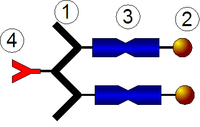
Photo from wikipedia
Dendrimers are branched molecules with well-defined lengths, shapes, molecular weights, and monodispersity in comparison to linear polymers. The dual effect of the chromophore luminescence and the morphology of the synthesized… Click to show full abstract
Dendrimers are branched molecules with well-defined lengths, shapes, molecular weights, and monodispersity in comparison to linear polymers. The dual effect of the chromophore luminescence and the morphology of the synthesized dendrimers has drawn a lot of interest towards the design of dendrimers with different chromophores. Furthermore, the stimulus-responsive systems can sequester drug molecules under a preset set of parameters and release them in a different environment in response to either an exogenous or endogenous stimulus. The addition of photoresponsive moieties to different dendrimer components, such as the core or branches, magnifies the importance of the dendrimer in several related sectors of nanotechnology, such as sensors, photoswitches, electronic gadgets, and drug delivery systems. This review article focused on photoresponsive/glycoside dendrimer structures and their biomaterial applications.
Journal Title: RSC Advances
Year Published: 2022
Link to full text (if available)
Share on Social Media: Sign Up to like & get
recommendations!